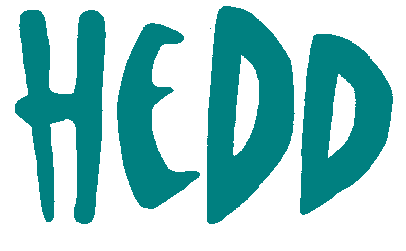

HARMONICALLY ENHANCED
DIGITAL DEVICE

OPERATOR'S MANUAL
VERSION 1.00
![]()
2117 East 5th. Street
Superior, WI 54880 USA
tel:715-398-3627 fax:715-398-3279


HARMONICALLY ENHANCED
DIGITAL DEVICE

OPERATOR'S MANUAL
VERSION 1.00
![]()
2117 East 5th. Street
Superior, WI 54880 USA
tel:715-398-3627 fax:715-398-3279
Panel Reference
HEDD, short for harmonically enhanced digital device, is a technological break through in signal processing. HEDD is engineered to provide musically pleasing sound with the capability of generating tube/analog sounds in the digital domain.
HEDD gives any user who works with digital the ability to sound less digital and more analog.
Applications include: CD preparation, work station input and output, DAT machine A/D and D/A convertor replacement and effects generation ( warming or changing sounds in the digital domain). HEDD can be used in tracking, mixing, and mastering.
The front panel controls allow the user to select input source, sample rate, and continuously variable triode and pentode sounds. The HEDD can operate as an effects device or as separate A/D and D/A convertor with the harmonic generation process applied to either the A/D or D/A convertor.
The signal processor performs 24 Bit Processing on digital or analog source.
HEDD has transformerless balanced analog inputs and outputs, transformer isolated digital inputs and outputs, and uses separate power transformers and supplies for the analog and digital sections. The unit is 1 rack space tall and operates from 115V or 230V mains.
Selects the A/D clock rate of 48Khz, 44.1KHz or external WC reference. It also selects the digital audio source. The s/pdif side of the switch selects s/pdif input and the AES side of the selects the AES input.
Clears the overload LED. It also clears the peak memory value.
Enables or disables the DSP process. There is a small time lag when the process is turned on and off.
The triode function creates a triode like harmonic structure. This affects the bottom of your signal by fattening it up. This function contains strong even order harmonics. It should be noted that even order harmonics may or may not be easy to hear depending on the program and how much you are adding. This function is not strictly even order harmonics. The harmonic structure changes with signal level and the amount of process being applied, just like it does in a tube and the analog world.
The pentode function creates mostly third harmonic information but contains some even order harmonics and some higher order odd harmonics depending on the signal level and the amount of process. This is like driving a pentode into over load in a controlled manner. The pentode process makes things sound brighter, brings out detail, and also affects the triode process because the two processes are in series. There is also a compression effect that takes place if you run the process at higher settings.
The process switch selects whether the signal processor is attached to the D/A convertor, A/D convertor, is configured for digital in - digital out, or analog in - analog out. See Process Block Diagrams
The harmonic process runs 24 bit internal. The digital inputs and outputs are also 24 bit. If you feed 24 bit digital in you will get 24 bit digital out. If you are recording 16 bit digital it is recommended that you listen to your 16 bit data and adjust the process so it sounds good. Keep in mind that HEDD generates harmonically related information. It is not a mathematicians answer to dithering, it was arrived at by analyzing harmonic distortion in prized equipment and a lot of listening. If you feed 16 bit audio into the process the process will generate 24 bit data because of its internal 24 bit calculations. This extra resolution is harmonically related information. If you use only 16 bits of the output it is not a problem. We recommend that if you are recording to 16 bits, monitor the process from the 16 bit output of your system to get optimum results in adjusting HEDD.
When using the process you will affect your average signal level if you turn the process up far enough. When adding harmonic content, the audio is going to get louder if it is modified to a great enough level. With the HEDD process, the peaks in your signal are being reduced while the low level harmonic content is being increased. What this means is that the HEDD process should not cause any overs. In fact, what it will do is reduce the level of existing overs. Think of it as a tube doing soft clipping, i.e. "squashing" the peaks.
There are no rules, but here are some general guidelines. Making it sound "good" is what it's all about. The process is level and program dependent. Settings that will work best for one source may not work at all for another source. If you need a general purpose setting try running the process knobs at 3.5 to 6. This should be safe. When you run the knobs in the 5 and up range it is easy to go too far but it could be a cool thing. Because we are not used to a musical device that changes harmonic content with a knob it will take a little learning. It is also good to be aware that the ear loves a little harmonic generation. Turning HEDD off can take the life out of your program material, even if you did not notice it turn on.
The amount of process can result in subtle changes or drastic changes depending on what the program is like and how much process is being added. In other words the difference between analog and digital recordings can be subtle or drastic. It will be easier to hear in material that is more open as opposed to material that is very dense. The amount of low frequency information will also affect how we hear the process.
In a 20 bit system if max signal level is +16dBm the noise floor would be -100 dBm if things were perfect. The best mic amp at 50 dB of gain will have a noise floor of approximately -80dBm. Dithering is adding noise to make the least significant bit toggle to average and randomize truncating errors. The mic amp noise is far greater than the dither level in a 20 bit system at 50 db of gain. In a 16 bit system, as above, the noise floor would be -84 dBm in a perfect world. It looks like the mic amp noise provides dither at 16 bits. HEDD does not dither; it generates harmonically related content and changes the low level bits values with added harmonic content, not noise.
The external WC connections are for A/D convertor synchronization with an external world. They do not effect the digital inputs because the digital inputs provide their own clock information. The input connection is used to synchronize the A/D convertor to an external source. The output connection is at the rate of the A/D convertor whether internal or external clock is selected and can be used as a sync. source. When HEDD recognizes and locks on to external WC and WC is selected on the front panel an LED by the sample rate switch lights up to indicate lock. If there is no lock HEDD defaults to a 44.1 KHz sample rate.
The meter is calculated by the DSP and follows the HEDD process, as selected by the process switch. The peak hold can be set to run in one of two different modes. First is a 2 second hold then the peak indicator will drop back to a lower level. In the second mode the peak value is held until the OVER RESET button is pushed. This mode is good for those of us that may have to leave the room and want to know what the maximum value was during the transfer. There is an internal jumper that can be changed or select either options. The default mode is memory or hold forever.
The over led lights on detecting a digital over load. This is done by the DSP. The over indicator will respond from the analog input when the process is selected as analog or A/D. The over indicator will respond to the digital source when the process is selected as digital or D/A. We are defining a digital over as a single sample overload.
HEDD can be used for many different tasks. It can be operated in; analog in / analog out; digital in / digital out; and as A/D and D/A convertors with the signal processor operation attached to either convertor.
You can put it on the stereo bus of a digital console feeding a digital device or have analog output. It can be used as the A/D convertor and D/A convertor for a digital tape multi track or a DAT machine. It can go between 2 DAT machines in the digital mode to process existing material. You can even use it to convert to analog for processing and then back to digital. HEDD is also useful for tracking and mixing, and it can be used analog in, analog out. It will allow you to do amazing things to individual tracks. HEDD can also be used in mastering as a convertor or as a digital in / digital out processor. HEDD opens up a new world of signal processing.
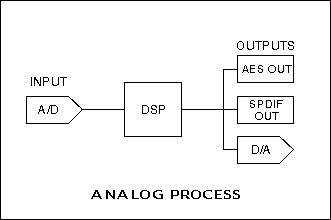
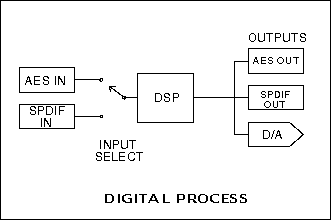
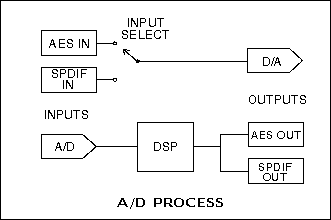
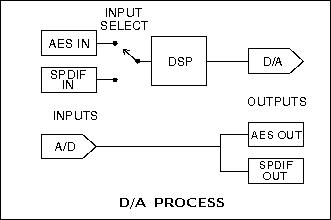
Transformer-less balanced floating stereo output with XLR connectors. Digital zero is +16dBm. This allows 12 db of headroom above a +4dBm 0 VU
Transformer-less balanced floating stereo with XLR connectors. Digital zero is +16dBm. This allows 12 db of headroom above a +4dBm 0 VU.
BNC connector takes a TTL level signal at the sample rate to sync the A\D to the external sample rate. HEDD will sync from 20 kHz to 50 kHz. The input impedance is 5K ohms.
BNC connector this is a TTL level square wave that can be used to provide sync to other equipment. The WC output will be the selected sample rate or the rate of the WC input. The output impedance is 75 ohms.
44.1kHz or 48kHz determined by front panel switch.
Unbalanced digital input 75 ohms RCA connector
Unbalanced digital output 75 ohms RCA connector
Balanced digital input 110 ohms XLR connector
Balanced digital output 110 ohms XLR connector
25 watts at 115 or 230 volts, 50 or 60 Hz.
Fuse size is MDL .25 A for 115 volts; MDL .125 A for 230 volts
Shipping Weight: 15 lbs (6.7kg)
Depth Behind Panel: 10 inches (25.4cm) plus user input/output connectors
HEDD uses high Quality 24 Bit A/D and D/A Convertors made by CRYSTAL semiconductor.
There are several internal jumpers that can be changed to suit individual tastes. We include this information in the manual shipped with the unit.
Back to Crane Song
Back to TOP
Back to Products
FUSE AND LINE VOLTAGE SWITCH LOCATION